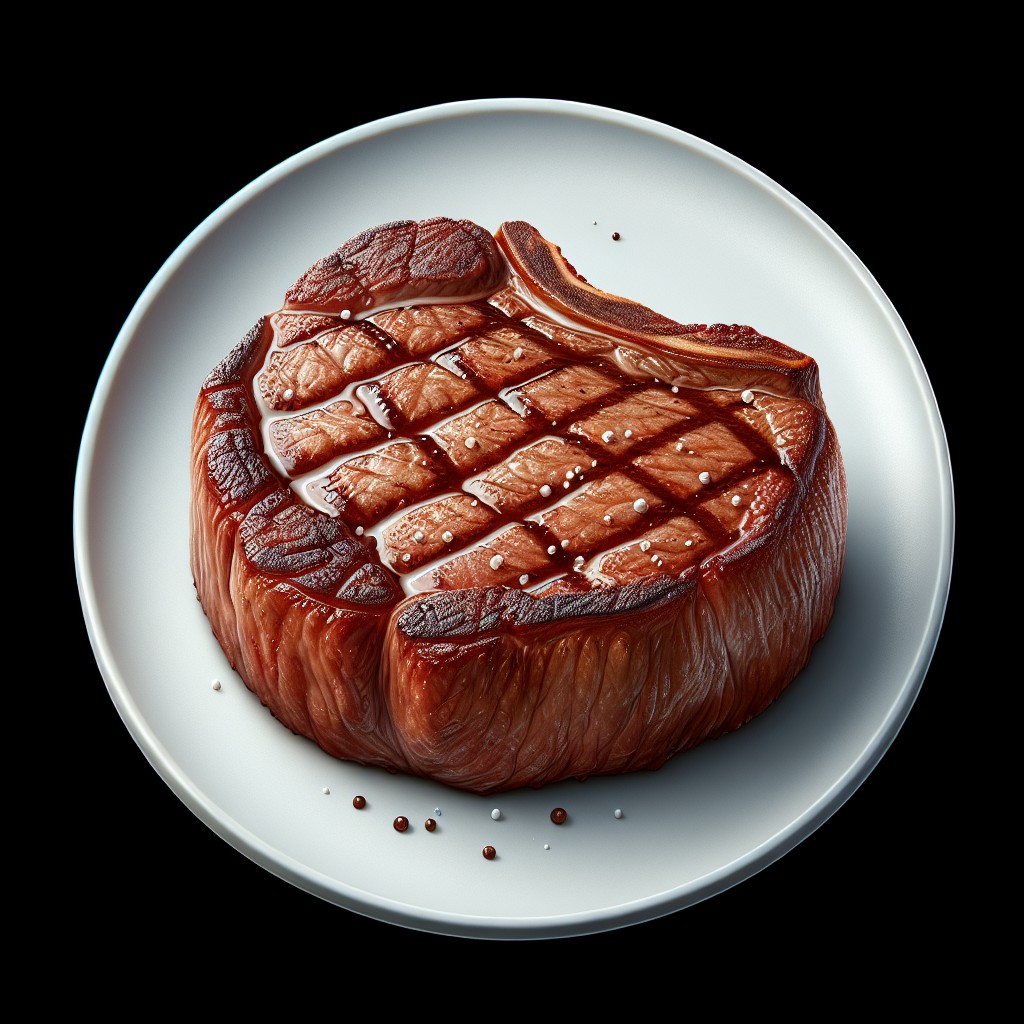Last updated on
Dive into this handy guide to understand exactly how sizable a 6 oz steak is, and the factors that can influence its dimensions.
Key takeaways:
- A 6 oz steak is roughly the size of a deck of cards.
- It is typically 3/4 inch thick by 4 inches wide and 5 inches long.
- The volume to weight ratio of a steak is influenced by fat content, bone-in versus boneless, cut thickness, and meat fiber structure.
- A 6 oz steak is considered a standard single serving size, but serving size considerations should also take into account accompaniments, appetite, and age group.
- Cooking a 6 oz steak can result in shrinkage due to water loss, fat rendering, cooking method, and cutting against the grain.
What's Inside
Visual Comparison of a 6 Oz Steak

Picture a deck of playing cards. That’s your best everyday object to visualize the size of a 6 ounce steak. It’s roughly the area that a pack of cards covers if you were to set it down on your plate.
In terms of thickness, think about two stacked smartphones. The precise thickness can vary depending on the cut; a filet mignon might sit taller like a squat tower, while a sirloin could stretch flatter like a paperback novel.
Thickness aside, if you can imagine your steak taking up no more real estate than that standard deck of cards, you’ve got a good sense of a 6 oz portion. This mental imagery is particularly handy when you’re selecting meat at the store or assessing portion sizes at a restaurant.
Typical Dimensions of a 6 Oz Steak

Considering a steak’s density, a 6 oz portion typically measures around 3/4 inch thick by 4 inches wide and 5 inches long.
That’s roughly the size of a deck of cards in thickness and a little larger in area.
Of course, these measurements can vary depending on the cut of the steak and how the butcher has prepared it.
A filet mignon, being a thicker cut, might be closer to 2 inches thick, but smaller in diameter, while a flatter cut like a skirt steak would cover more plate area but be less thick.
Keep in mind, the cut’s shape affects cooking time and method, so choosing a steak that matches your culinary plans is as important as the weight.
Volume to Weight Ratio
Understanding the volume to weight ratio is key when eyeballing steak sizes without a scale. Essentially, this ratio reflects the density of the meat. As a rule of thumb, denser cuts will have a smaller volume at the same weight compared to less dense cuts.
Here’s what influences this ratio for a steak:
- Fat content: Fattier cuts have a lower density, giving you a slightly larger piece for the weight.
- Bone-in versus boneless: A boneless steak will present more edible meat at the 6 oz mark, while a bone-in steak includes the weight of the bone in those 6 ounces, meaning less meat volume.
- Cut thickness: Two 6 oz steaks can look different based on how thickly they are cut. A thinner cut will have a larger surface area, while a thicker cut presents a smaller surface but greater height.
- Meat fiber structure: The way the muscle fibers are aligned can affect how densely the meat is packed, with tightly grained meats seeming smaller at the same weight.
Remember, the volume to weight ratio won’t significantly alter the meat’s actual weight, but it does impact the perceived size. Using this knowledge can help you select a steak that meets your expectations for size and satisfaction.
Serving Size Considerations
When selecting a steak for your meal, it’s helpful to keep in mind that a 6 oz portion is considered a standard single serving size by dietary guidelines. This aligns with the recommended protein portion per meal, which can be particularly useful for those tracking their intake for weight management or health reasons.
For those hosting a dinner or planning a menu, it’s important to consider the accompaniments. A 6 oz steak pairs well with sides such as vegetables and grains, making for a well-rounded plate without overwhelming with too much protein.
For individuals with larger appetites or for meals where the steak is the star without many sides, a larger cut may be more appropriate. Conversely, those who prefer a lighter meal or plan to indulge in appetizers or desserts might find a 6 oz steak to be just the right size.
Lastly, understanding your audience is key. Children and seniors typically consume less, so a 6 oz steak might be shareable or simply too large, whereas athletes or those with higher caloric needs may view it as a starting point.
By considering these factors, diners and cooks can better judge whether a 6 oz steak is the appropriate serving size for their needs.
Cooking Shrinkage Effect
It’s a little-known but inescapable fact: steaks shrink when cooked. Heat causes the muscle fibers and fat within the meat to contract and lose moisture, leading to a reduction in size.
Here’s what you need to know:
- Water loss: A steak is about 60-70% water. Cooking a steak at high heat evaporates this water, leading to shrinkage.
- Fat rendering: The fat within a steak melts away with heat, and this rendering process contributes to the overall shrinkage.
- Cooking method impact: How you cook your steak affects shrinkage. Grilling or broiling can result in a 25-30% reduction in weight, while slower methods like sous-vide minimize shrinkage.
- Cutting against the grain: After cooking, cutting a steak against the muscle fibers can make it seem larger and more substantial on the plate.
Remember, a 6 oz steak prior to cooking might weigh approximately 4.5 to 5 oz post-cooking – a natural occurrence in the journey from grill to plate.
Butcher’s Breakdown
When assessing a 6 oz steak, it’s insightful to consider how a butcher views portion sizes. They apply precise techniques to ensure that each cut meets the expected weight.
- Precision Cutting: Butchers utilize sharp tools and expert knowledge of beef anatomy to carve steaks to an approximate size, aiming for a uniform thickness to promote even cooking.
- Yield from the Cut: A steak’s origin within the cow matters; a 6 oz steak might come from a larger section like the ribeye or tenderloin, where butchers can get multiple 6 oz portions from a single piece.
- Trimming Fat: A butcher often trims the excess fat before weighing, which can impact the final size. The goal is to strike a balance – keeping enough fat for flavor while removing excess.
- Bone-In vs. Boneless: A 6 oz boneless steak will differ in overall size compared to a bone-in cut; the former is purely meat, while the latter includes the weight of the bone.
Understanding the butcher’s approach contributes to appreciating the intricacies behind your steak’s size and helps set expectations for what ends up on your plate.
Nutritional Information
A 6 oz steak is more than just a hearty portion of protein; it’s a powerhouse of various nutrients essential for maintaining good health. Primarily, it’s a fantastic source of complete protein, providing about 42 grams, which is critical for muscle repair and enzyme function.
In addition, this serving size delivers approximately 12% of the recommended daily iron intake, vital for oxygen transport in the blood.
The steak’s marbling, which is the intramuscular fat, contributes to its calorie count—roughly 330 calories, depending on the cut and preparation method. However, it’s this fat that also imparts rich flavors, making the steak indulgent and satisfying.
Furthermore, it contains other key nutrients such as B vitamins, especially B12, necessary for proper nervous system function and metabolism. Zinc, also present in good quantities, supports immune health and wound healing.
Despite its nutritional benefits, it’s important to balance steak intake with other food groups due to its saturated fat content, which should be consumed in moderation for heart health.
Beef Grading
Understanding beef grading is crucial when selecting a steak. The United States Department of Agriculture (USDA) grades beef based on several criteria, including marbling, age of the animal, and firmness of the meat. These factors directly influence the quality, flavor, and tenderness of your steak.
The USDA’s top three grades you’ll likely encounter are:
- Prime: This is the highest quality, with abundant marbling, which equates to juiciness and flavor. A 6 oz steak with this label is typically found in high-end restaurants and specialty meat shops.
- Choice: Slightly less marbling than Prime, but still high in quality, a Choice-grade steak offers a balance of tenderness and flavor at a more moderate price point.
- Select: Lower in marbling, these steaks can be less tender and flavorful. They’re more budget-friendly and can still provide an enjoyable meal with the right cooking method.
The grade affects not only the eating experience but also the price. Higher-grade meats tend to be more expensive. When shopping for a 6 oz steak, consider how the beef was graded to better understand the quality and value you’re getting for your money.
Cooking Tips
Achieving the perfect cook on a 6 oz steak is an art form that hinges on attention to detail. Here’s how you can master this skill:
- Preheat the Pan: Heat your skillet over high heat before adding the steak to achieve an instant sear which locks in juices.
- Room Temperature: Allow your steak to sit out for about 20 minutes before cooking. This promotes uniform cooking throughout.
- Season Generously: Before cooking, give the steak a hearty sprinkle of salt and pepper for a flavor-packed crust.
- Don’t Overcrowd: Cook one steak at a time or ensure there is ample space between them to avoid steaming and to achieve a proper sear.
- Use a Timer: For a medium-rare finish, aim for about 4 minutes on each side, adjusting time based on thickness and desired doneness.
- Let It Rest: This is crucial. Rest your steak for at least 5 minutes post-cooking to let the juices redistribute, ensuring a moist bite.
- Internal Temperature: For precision, use a meat thermometer. Medium-rare is around 145°F, medium 160°F, and well-done 170°F.
Implement these tips to enhance the natural flavors and textures of your 6 oz steak, turning a simple cut into a memorable dish.
FAQ
Is a 6 oz steak a good size?
A 6 oz steak is indeed considered a substantial serving, providing ample protein, although it is double the suggested 3 oz portion size, likened to the dimensions of a card deck or your palm.
How many servings is a 6oz steak?
A 6oz steak equates to two servings in a daily dietary plan.
Is 8 oz of steak a lot?
While the standard serving size is indeed 8 ounces of steak, this can vary based on individual dietary needs and preferences.
How big is a normal steak Oz?
A standard steak portion can vary extensively, from an average of 9 oz in regular restaurants, climbing to around 12 oz in steak houses, with a T-bone steak weighing in at about 16 oz.
How does a 6 oz steak’s portion size compare to dietary guidelines?
A 6 oz steak, which is approximately 170 grams, exceeds the USDA’s recommended daily protein intake of 5-6.5 ounces for adults, indicating a larger portion size than dietary guidelines suggest.
What nutritional value does a 6 oz steak offer?
A 6 oz steak typically provides about 42 grams of protein, 12 grams of fat, 345 calories, and various nutrients including Iron, Vitamin B12, Zinc, and Selenium.
How to properly cook a 6 oz steak to maximize flavor and texture?
To properly cook a 6 oz steak and maximize flavor and texture, sear it on high heat for 1-2 minutes each side, then lower the heat and cook for another 2-3 minutes while regularly applying a mixture of herbs and butter.





